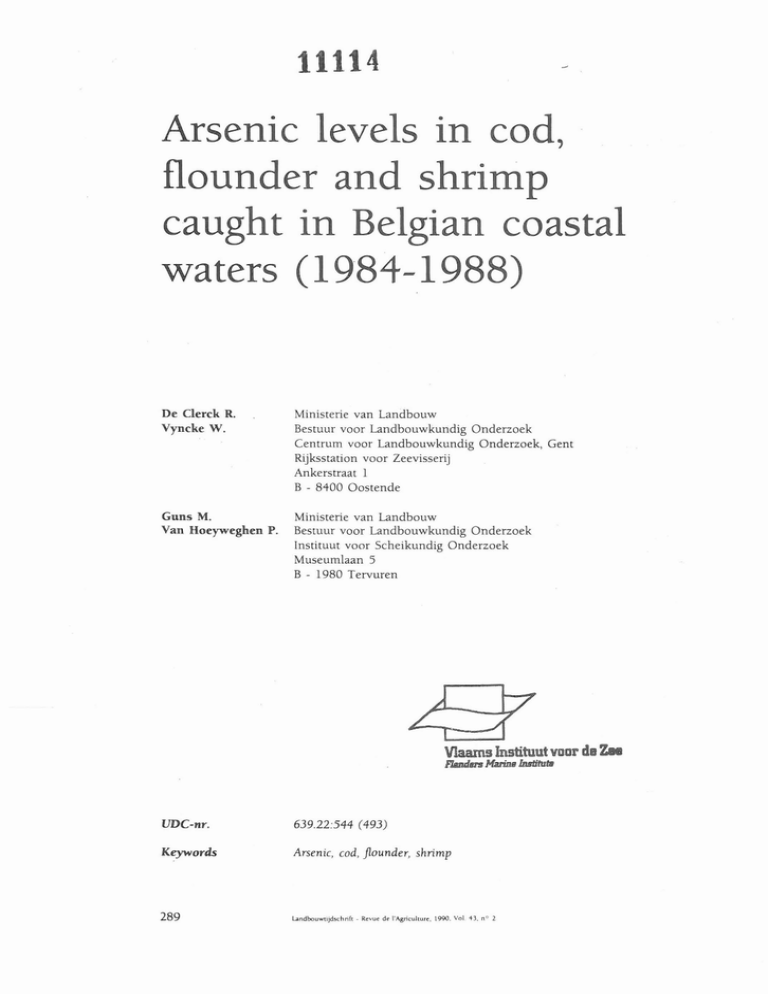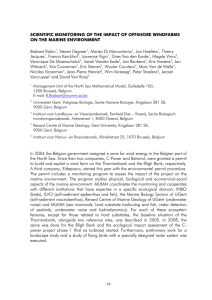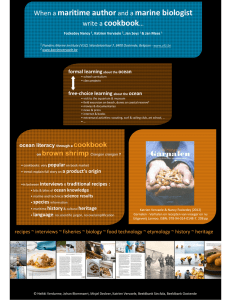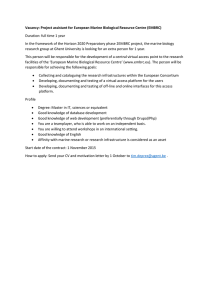984- 1988) Arsenic levels in cod, and shrimp flounder
advertisement

Arsenic levels in cod, flounder and shrimp caught in Belgian coastal waters (1984- 1988) De Clerck R. Vyncke W. Ministerie van Landbouw Bestuur voor Landbouwkundig Onderzoek Centrum voor Landbouwkundig Onderzoek, Gent Rijksstation voor Zeevisserij Ankerstraat 1 B - 8400 Oostende Guns M. Van Hoeyweghen P. Ministerie van Landbouw Bestuur voor Landbouwkundig Onderzoek Instituut voor Scheikundig Onderzoek Museumlaan 5 B - 1980 Tervuren U Vlasrms Instituut voor de Zw E ~ ~ ~Marine L u sW t u t a UDC-nr. 639.22544 (493) Keywords Arsenic, cod, pounder, shrimp Summary Arsenic was determined in cod (Gadus morhua), flounder (Platichthys Jesus) and brown shrimp (Crangon crangon) during a five years' period (1984-1988). Cod and flounder were divided into five length categories; 25 specimens were analyzed individually. For shrimp, a bulked sample of 100 cooked and peeled animals was taken. In cod, arsenic levels did not appear to be influenced by the length (age) of the fish, whereas in flounder, the content clearly increased with length. Average values of both fish species were quite similar, ranging from 2.5 to 5.4 mg/kg in cod and 2.4 to 4.1 mg/kg in flounder. No clear temporal trend could be observed. Individual variations were large. Arsenic concentrations in shrimp (4 to 10 mg/kg on average) were higher than in the two fish species with greater yearly variations. No , significant temporal trend was noted. High values which were recorded in some fishery products, especially in flatfish, were not found during the present investigations. No problems are likely to occur with respect to human consumption. For the purpose of monitoring arsenic levels in the marine environment, shrimp with their higher concentration appear to be more appropriate than fish. 1. Introduction Arsenic is present in marine organisms at much higher concentrations than in terrestrial animals (Chapman et al., 1926; Doyle et al., 1978). The major arsenicals however have been shown to be water soluble organic compounds which are much less toxic than the inorganic salts (Westoo et al., 1972; Shinagawa 'et al., 1983). In 1977 Edmonds et al. isolated and characterized arsenobetaine (trimethylarsoniumacetate) in rock lobster. Further investigations showed this compound to represent more than 70 % of the total arsenic concentration in most marine organisms (Kurosama et al., 1980; Edmonds et al., 1981a; Luten et al., 1983; Shiomi et al., 1983, 1984). Arsenobetaine is quite stable and is considered to be non toxic (Penrose, 1974). The major part of the organic arsenic ingested via fishery products is rapidly excreted unchanged (Freeman et al., 1979). A genotoxicity study of arsenobetaine did not show any effect of this compound (Jongen et al., 1985). Inorganic arsenic compounds on the other 290 hand are highly toxic and show a carcinogenic effect. For this reason the Joint Expert Committee of the FAO/WHO (1983) recommends an acceptable daily intake of 2 pg inorganic arsenic per kg body weight. The levels of inorganic arsenicals however seldom exceed 0.1 mg per kg wet weight. (Lunde, 1973; Brooke et al., 1981; Flanjak, 1982; Shinagawa et al., 1983). It is further known that marine biota in lower trophic level (bacteria, plankton) can transform inorganic arsenicals into organic ones while these in higher trophic levels can not (Shiomi et al., 1984). These marine animals do not take up organic arsenicals from sea water but from their baits. Excretion of organic arsenic however is quick and no accumulation in the food chain with increasing trophic level was observed (Penthreath, 1977; Wrench et al., 1979; Edmonds et al., 1981b). Arsenic in marine biota appears to be mainly of natural origin (Penrose, 1974; Andrea, 1978; Edmonds et al., 1981a). However in some areas such as estuaries anthropogenic inputs can increase the arsenic Landbouwt~jdschnfr- Revue de I'Agnculrure, 1990,Vol 43. no 2 levels significantly (De Groot et al., 1976; Michel, 1987). Within the framework of the Belgian monitoring programme on trace contaminants, the analysis of arsenic in cod (Gadus morhua), flounder (Platichthys fiesus) and brown shrimp (Crangon crangon) was included from 1984 onwards. This paper Table 1 reports results for the five years' period 1984-1988. 2. Material and methods 2.1. Samples Cod, flounder and shrimp were caught off the Belgian coast by trawling. According to Average arsehic content in cod (mg/kg wet weight)(a) Length category (mm) 1984 1985 1986 1987 1988 Total 4.8 (38.0) 5.4 (40.6) 2.5 (48.0) 3.7 (24.8) 3.1 (45.2) (a) Coefficient of vanation (%) in brackets Table 2 Average arsenic content in flounder (mg/kg wet weight)(a) Length category (mm) 1984 1985 < 231 1.8 (131.0) 2.6 (73.4) Total 3.7 (36.0) 3.0 (44.1) 1986 3.8 (55.0) (a) Coefficient of variation (%) in brackets 29 1 Landboulni~dschnfi- R L W ~dr I'Agnculrurc. 1990. Vol 43. no 2 1987 1988 3.5 (33.9) 1.7 (106.2) 4.1 (62.4) 2.4 (72.9) the guidelines of the International Council for the Exploration of the Sea (ICES, 1983) the fish specimens were divided into five length categories with 35 and 40 mm ranges for flounder and cod respectively (tables 1 and 2). It was however not possible to maintain the same categories over the five years' period, due to changes in the composition of the catches. A total of 25 specimens of both fish species were assessed individually. One bulked sample of 100 cooked and peeled Figure 1 Relationship between length and average arsenic content in flounder 5 200 250 300 350 400 m m shrimps was analysed. 2.2. Determination of arsenic One g of fish is weighed in a digestion bomb with Teflon liner (Parr 4746). After addition of 2 m1 concentrated nitric acid, the bomb is placed in an oven and heated at 150° C for 1 1/2 hr. After cooling, 8 m1 of bidistilled water is added. Determination is canied out by graphite furnace atomic absorption spectrometry (Varian SpectrAA 400 ZEEMAN). The furnace is equipped with a graphite tube with platform. A matrix modifier (Pd 0.04 O h + Ni 0.1 %) is added. The ashing temperature is 1400° C, the atomizing temperature 2600' C. A standard curve is prepared using 3, 6 and 9 p1 of a standard solution containing 50 pg /l arsenic (Van Hoeyweghen et al., 1985; Hoenig et al., 1986). 3. Results and discussion The average arsenic concentrations in cod and flounder are reported in tables 1 and 2 respectively. In cod, arsenic levels did not appear to be influenced by the length (age) ofthe fish, whereas in flounder, the content clearly increased with length. Fig. 1 shows the regression between mean arsenic concentrations and length categories. The two classes 336-370-and > 405 mm (1986) were ( ) Values oi 1986 not taken into account for the calculation of the linear regression Figure 2 Evolution of the average arsenic concentrations in shrimp, cod and flounder during the period 1984-1988 S: shrimp, C: cod; F: flounder Table 3 Arsenic levels in cod, flounder and shrimp born other areas (mglkg wet weight) Species Area Mean Reference Cod Newfoundland waters NW-Atlantic Icelandic waters Norwegian waters Scottish waters North Sea 0.8 3.5 f 1.7(a) 0.8 f 0.4(a) 3.1 l .3 4.3 Kennedy 1976 Zook et al. 1976 id Anon. 1977 Falconer et al. 1983 Vos et al. 1986 Flounder North Sea 37 Luten et al. 1983 Shrimp North Sea 3.8 Vos et al. 1986 (a) Standard deviation not taken into account for the calculation of the linear regression because only one figure was available. They are however shown in fig. 1. An increase in arsenic levels with age or weight of fish was also observed in the related species plaice (Pleuronectes platessa) (Shepherd et al., 1977). The total average values of both fish species were quite similar, ranging form 2.5 to 5.4 mg/kg in cod and 2.4 to 4.1 mg/kg in flounder. No clear temporal trend could be observed (fig. 2). The large variations in arsenic content should be stressed. This was also reported for other marine organisms and is probably due to variations in the arsenic concentrations of their preys (Zook et al., 1976; Pentreath, 1977; Michel, 1987). In general round fish, which feed primarily on small fish contain less arsenic than flat fish whose food consists of bottom living invertebrates, small crustaceans, molluscs and worms (Shepherd et al., 1977; Michel, 1987). This was not confirmed for cod during the present investigations but it should be remarked that cod caught off the Belgian coast are young fish (mainly 1-2 years old) which prey especially on benthic organisms, before leaving for deeper waters. The arsenic levels in shrimp were higher than in the two fish species. It is known that crustaceans and molluscs generally contain higher amounts of arsenic than fish (Zook et al., 1976; Michel, 1987). Yearly variations also appeared to be more important than in cod and flounder. For this reason the apparant slight increase of the arsenic level over the five years' period was not statistically significant when a linear time trend (regression) was calculated. Arsenic levels reported in other areas are mentioned in table 3. Cod and flounder compare quite well with Dutch data from the North Sea. Concentrations in shrimp were somewhat higher. On the other hand, high values (e.g. more than 50 mg/kg) which were recorded in some fishery products, especially flat fish, were not found during this study (Luten et al., 1982; Falconer et al., 1983). Conclusions No problems related to arsenic are likely to occur with respect to human consumption. For the purpose of monitoring arsenic levels in the marine environment, shrimp with their higher concentration appear to be more appropriate than fish. References - ANDREAE, M. 1978. Distribution and speciation of arsenic in natural waters and some marine algae. Deep sea Research, 25, 391-402 - HOENIG, M,, VAN HOEYWEGHEN, P. 1986. Determination of selenium and arsenic in animal tissues with platform furnace atomic absorption spectrometry and deuterium background correction. International Journal of Environmental Analytical Chemistry, 24, 193. - ANONYMUS. 1977. Report from the Government Vitamin Institute, Bergen, Norway. - ICES 1983. Report of the ICES Advisory Com- BROOKE, P. and EVANS, W. 1981. Determina- mittee on Marine Pollution 1982. Cooperative Research Report No. 120. International Council for the Exploration of the Sea, Copenhagen. tion of total inorganic arsenic in fish, shellfish and fish products. Analyst, 106, 514-520. - CHAPMAN, A. 1926. On the presence of com- - pounds of arsenic in marine crustaceans and shellfish Analyst, 51, 548-563. - DE GdOOT, A. and ALLERSMA, F. 1976. Field observation on the transport of heavy metals in sediments. In: Krenkel, P. (Ed): Heavy metals in the aquatic environment pp 85-95. Pergamon Press, London. - DOYLE, J. and SPAALDING, J. 1978. Toxic and essential trace elements in meat - A review. Journal of Animal Science, 47, 398-408. - JONGEN, W., CARDINAALS, J., BOS, P. and HAGEL, P. 1985. Genotoxicity testing of arsenobetaine, the predominant form of arsenic in marine fishery products. Food Chemical Toxicology, 23, 669-673. - - EDMONDS, J., FRANCESCONI, K., CANNON, J., , RASTON, C., SKELTON, B. and WHITE, A. 1977. Isolation, crystal structure and synthesis of arsonobetaine, the arsenical constltuant of the Western rock lobster Panulirus longipes Cygnus George. Tetrahedron Letters, 18, 1543-1546. - EDMONDS, J., FRANCESCONI, K. 1981 a. The origin and chemical form of arsenic i n the school whiting. Marine Pollution Bulletin, 12, 92-96. - EDMONDS, J., FRANCESCONI, K 1981 b. Arseno-sugars from brown kelp (Echlonia radiata) as intermediates in cycling of arsenic in a marine ecosysteem. Nature, 289, 602-604. - FALCONER, C., SHEPHERD, R., PIRIE, J. and TOPPING, G. 1983. Arsenic levels In fish and shellfish from the North Sea. Journal of Experimental Marine Biology and Ecology, 71, 193-203. Joint Expert Committee of the FAO/WHO 1983. The evaluation of certain food additives and contaminants, 27th Report. Technical Report Series No 696. World Health Organization, Geneva. KENNEDY, V. 1976. Arsenic concentrations in some coexisting marine organisms from Newfoundland and Labrador. Journal of the F~sheriesResearch Board of Canada, 33, 1388-1393. - KUROSAWA, S., YASUDA, K., TAGUCHI, M., YAMAZAKI, S., TODA, S., MORITA, M., UEHIRO, T and FUWA, K. 1980. Identification of arsenobetaine, a water soluble organo-arsenic compound in muscle liver of a shark, Prionace glaucus. Agricultural and Biological Chemistry, 44, 1993-1994. - LUNDE, G. 1973. Separation and analysis of organic-bound and inorganic arsenic in marine organisms. Journal of the Science of Food and Agriculture, 24, 1021-1027. - LUTEN, J., RICKWEL-BOOY G. and - FLANJAK, J. 1982. Inorganic and organic RAUCHBMR, A. 1982. Occurrence of arsenic in plaice (Pleuronectes platessa), nature of organn-arsenic compound present and its excretion by man. Environmental Health Perspectives, 45, 165-170. - LUTEN. J., RICKWEL-BOOY G., VAN DER GREEF, J. and ten NOEVER de BRAUW, M. 1983 Identification of arsenobetaine in sole, lemon sole, flounder, dab, crab and shrimp by field desorption and fast atom bombardement mass spectrometry. Chemosphere, 12, 131-141. - PENROSE, W. 1974. Arsenic in the marine and aquatic environment : analysis, occurrence and significance. CRC Reviews in Environmental Control, 4, 465-482. arsenic in some commercial Australian crustacea. Journal of the Science of Food and Agriculture, 33, 579-583. - FREEMAN, H., UTHE, J. FLEMING, R., ODENSE, P,, ACKMAN, R., LANDRY, G. and MUSIAL, C. 1979. Clearance of arsenic ingested b y man from arsenic contaminated fish. Bulletin of Environmental Contamination and Toxicoiogy, 22, 224-229. Landbouwuldrchnft - ~ c v u rde I'Agnculrure. 1990. Vol 4,. n'- r - PENTREATH, R. 1977. The accumulation o l arsenic by the plaice and Thornback ray: some preliminary observations. ICES CM 19771E:17. International Council for the Exploration of the Sea, Copenhagen. habits. Bulletm of the Japanese Society of Scientific Fisheries, 50, 293-297. - VAN HOEYWEGHEN, P., HOENIG, M. 1985. Etude comparative de divers modes de mineralisation de tissus animaux en vue de la determination de l'arsenic par spectrometrie d'absorption atomique electrothermique. Analusis, 19, 275. - SHEPHARD, R. and TOPPING, G. 1977. Arsenic in fish and shellfish from Scottish waters. ICES CM 1977/E:38. International Council for the Exploration of the Sea, Copenhagen. - VOS, G., HOVENS, J. and HAGEL, P. 1986. - SHINAGAWA, A., SHIOMI, K., YAMANAKA, H. and KIKUCHI, T. 1983. Selective determination of inorganic arsenic (III), (V), and organic arsenic in marine organisms. Bulletin of the Japanese Society of Scientific Fisheries, 49, 75-78. - - SHIOMI, K., SHINAGAWA, A.. YAMANAKA, H., and KIKUCHI, T. 1983 Purification and identification of arsenobetaine from the muscle of an octopus Paroctopus dolfeini. Bulletin of the Japanese Society of Scientific Fisheries, 49, 79-83. SHIOMI, K., SHINAGAWA, A., IGARASHI, T., HIROTA, K.,YAMANAKA, H., and KIKUCHI, T 1984. Contents and chemical forms of arsenic in shellfishes In connection with their feeding Chromium, nickel, copper, zinc, arsenic, selenium, cadmium, mercury and lead in Dutch fishery products 1977-1984. The Science of the Total Environment, 52, 25-40. - WESTOO, G. and RYDALV, M. 1972. Arsenic - - levels in food. Var Fodz, 24, 21-40. WRENCH, J., FOWLER, S. and UNLU, M. 1979. Arsenic metabolism in a marine food chain. Marine Pollution Bulletin, 10, 18-20. ZOOK, E., POWELL, J., HACKLEY, B., EMERSON, J., BROOKER, J. and KNOBL, G. 1976. National Marine Fisheries Service preliminary survey of selected seafood for mercury , lead, cadmium, chromium and arsenic content. Journal of Agriculture and Food Chemistry, 24, 47-53. Samenvatting Arseengehalten in kabeljauw, bot en garnaal gevangen in Belgische kustwateren Arseen komt in mariene organismen in sterkere koncentraties dan in landdieren voor. Meer dan 70 % bestaat echter uit arsenobetaine, dat niet toxisch blijkt te zijn. Anorganisch arseen daarentegen is zeer toxisch en carcinogeen. In het kader van het Belgisch monitoringprogramma van kontaminanten werd de dosering van arseen in kabeljauw (Gadus morhua), bot (Platichthys flesus) en garnaal (Crangon crangon) vanaf 1984 uitgevoerd. De resultaten van d e periode van 1984-1988 worden hier gerapporteerd. Kabeljauw en bot werden in vijf lengtekategorieen ingedeeld. Van iedere soort werden 25 specimens individueel ontleed. Voor garnaal betrof het een mengmonster van l 0 0 gekookte en gepelde dieren. In kabeljauw werd het arseengehalte niet door de lengte (leeftijd) van d e vis beinvloed. In bot echter steeg d e koncentratie 295 duidelijk met de lengte. De gemiddelde arseengehalten waren voor beide vissoorten vrij gelijk, varierend van 2,5 tot 5,4 mg/kg in kabeljauw en 2,4 tot 4 , l mg/kg in bot. Een duidelijke trend kon niet worden vastgesteld. De individuele arseenkoncentraties schommelden sterk. Dit is vermoedelijk te wijten aan d e variaties in d e arseenniveau's van d e prooien, d e enige mogelijkheid voor d e vissen o m arseen o p te nemen. Het arseengehalte in garnalen (gemiddeld 4 tot 1 0 mg/kg) was hoger dan in de twee vissoorten, hetgeen door andere onderzoekers eveneens werd vastgesteld. De jaarlijkse schommelingen waren eveneens groter. Voor dit Schaaldier werd evenmin een signifikante trend vastgesteld. De gevonden arseenkoncentraties komen vrij goed met deze van de literatuur overeen. Hoge waarden zoals genoteerd in bepaalde ~ ~ ~ d b ~ ~- ~~c vru e~dr ~rAgnculture. d ~ ~ h1990 ~ l Vol t 43. . n 2 vissoorten, vooral platvissen, werden niet aangetroffen. In verband met de konsumtjtie van vis stellen de arseengehalten geen probleem. Wat betreft het monitoringprogramma van arseeil in het mariene milieu, blijken !$arnalen met hun hoger gehalte beter geschikt dan vissen te zijn. Resume Les taux d'arshic duns le cabillaud, le Jet et la crevette pzches d a m les e a u cBtiires belges ,,! +", S r b L'arsenic est present dans les organismes rnarins a des taux nettement plus eleves que dans les animaux terrestres. Plus de 70 % cependant se compose d'arsenobetaine, qui ne semble pas avoir d'effets toxiques. L'arsenic inorganique par contre est tres toxique et cancerigene. Dans: le cadre du programme belge de surveillance des contaminants, le dosage de l'arseniic dans le cabillaud (Gadus morhua), le flet'(Platichthys Jesus) et la crevette (Crangon r ;rangon) .a ete effectue a partir de 1984. Les dj-esult?ts de Id periode 1984-1988 sont publies ici. Le cabillaud et le flet etaient classes en cinq categories basees sur la longueur; 25 specimens de chaque espece etaient analyses. Dans le cabillaud, le taux d'arsenic n'etait pas influence par la longueur (2ge) d u poisson. Dans le flet, par contre, la concentration augmentait avec la longueur. Les taux moyens d'arsenic etaient assez semblables pour les deux especes de poisson, variant de 2,5 a 5,4 mg/kg dans le cabillaud et de 2,4 a 4 , l mg/kg dans le flet. Aucune evolution dans.le temps n'etait constatee. Les concentrations individuelles d'arsenic variaient fortemenr. Ceci est probablement dfi aux niveaux d'arsenic fluctuants dans les proies, seule possibilite pour les poissons d'ingerer de l'arsenic. Le taux d'arsenic dans la crevette (4 a 10 mg/kg en moyenne) etait plus eleve que dans les deux especes de poissons, ce qui a egalement ete note par d'autres chercheurs. Les fluctuations annuelles etaient egalement plus fortes. Aucune evolution significative dans le temps tl'etait par ailleurs constatee dans ce crustace. Les concentrations d'arsenic trouvees concordent bien avec les donnees de la litterature. Des valeurs elevees, notees pour certaines especes surtout de poissons plats n'ont pas ete enregistrees dans la presente etude. Les taux d'arsenic ne posent aucun probltme en ce qui concerne la consommation de poisson. Quant au programme de surveillance de l'arsenic dans le milieu marin, la crevette, avec son niveau plus eleve semble Ctre un meilleur indicateur que les poissons.


